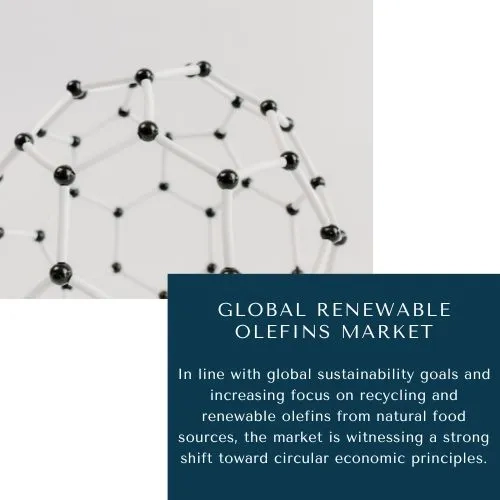
- Get in Touch with Us

Last Updated: Apr 25, 2025 | Study Period: 2024-2030
The global renewable olefins market is set to witness significant growth, driven by increasing demand for sustainable alternatives to conventional petrochemical-derived olefins and environmental impact meeting regulations that are difficult to improve efficiency. Commercialization has become easier - Combining renewable energy such as solar and wind into renewable olefin production is emerging as a key strategy to reduce carbon footprints and improve sustainable manufacturing practices , which have expanded their applications in various areas, including packaging and automotive.
Responding to global sustainability goals and increasing emphasis on circular economic principles, the renewable olefins market sees a significant shift towards renewable a in use, promoting recycling The growing bioplastics industry is a key driver of demand, as manufacturers to produce compostable biodegradable plastics Strategic partnerships have key players a searching for environmentally friendly alternatives between conventional olefins enables R&D growth, accelerates innovation and expands markets.

Investment opportunities in companies with abundant biomass resources and supportive regulatory frameworks are common, especially in North America, where strong infrastructure, technological advances and good government policies are driving adoption of renewable chemicals. The focus on non-food-based sustainable feedstocks further underscores the marketâs commitment to reducing competition for resources and enhancing environmental sustainability.
Renewable olefins are hydrocarbons derived from renewable sources such as biomass, vegetable oils, recycling waste, etc., which provide more sustainable alternatives than olefins using conventional petrochemicals. The use of these bio-based chemicals is due to the use of chemicals similar to conventional olefins plastic rubber, and synthetic fiber.
Increasing emphasis on reducing emissions greenhouse gas emissions as building materials in a wide range of manufacturing industries including those dependent on fossil fuels has accelerated the development and adoption of renewable olefins to provide economical practices that circular, technologies improved has also been important in ensuring the sustainability of the processes
The global renewable olefins market experiences robust growth driven by increasing demand for environmentally friendly alternatives to petrochemical derived olefins and environment compliance with stringent regulations Innovations in synthetic techniques and biosynthesis techniques have improved the efficiency and scalability of the regeneration of olefins. Their widespread use in areas such as consumer goods has led to an expansion of the renewable olefins market as industries seek to reduce their carbon footprint and meet sustainability goals of the industry, implying a combination of capital investment in R&D and renewable energy to improve productivity.

The Global renewable olefins market accounted for $XX Billion in 2023 and is anticipated to reach $XX Billion by 2030, registering a CAGR of XX% from 2024 to 2030.
Advanced catalytic methods :Recent advances in synthetic processes have transformed the renewable olefins by dramatically increasing the efficiency and selectivity of biomass conversion These advances include the use of new raw materials and improving optimization techniques such as metathesis and hydration. By increasing process speed and reducing energy consumption, these catalysts enable cost-effective, scalable manufacturing processes. This not only improves productivity but also reduces environmental impact, making renewable olefins more viable than their petrochemical counterparts in various industrial applications.
Integrating renewable energy :The integration of renewable energy sources such as solar and wind energy into renewable olefin production represents a transformative shift towards sustainability. This approach will replace fossil fuel based energy sources with clean alternatives substitutes to stimulate olefin synthesis and production. The use of renewable energy allows manufacturers to significantly reduce their carbon footprint and reduce energy costs, especially in regions with abundant renewables. This integration helps the world all carbon recycling processes but also enhances the economic and environmental appeal of renewable olefins for those seeking sustainable solutions. has become an increasingly attractive option for businesses.
Development of Bio-based Nanocomposites :The development of bio-based nanocomposites, incorporating nanosized particles in renewable olefins, pushes the boundaries of materials performance These nanocomposites exhibit advanced mechanical, thermal, and barrier properties, making them automotive, space, and high performance packaging Suitable for demanding applications in the fields Using nanotechnology, these materials have better strength, stability and performance, expanding the potential applications of renewable olefins beyond traditional applications This innovation not only opens up new market opportunities but creates a new development in the field, renewable olefins. It positions itself as a competitive and versatile alternative to traditional products.
Bazan Ltd. Launches Green Polyolefins:Bazan Ltd announced its entry into the renewable olefin market by producing green polyolefin from renewable food sources such as used cooking oil (UCO) at its Haifa Bay refinery in Israel Saa strategy backed by ISCC certification is great in sustainable polymer manufacturing Marks a breakthrough, enabling Bajan to add green ethylene and propylene to its polypropylene and polyethylene manufacturing Market impact is profound : positions Bajan as a key player in the growing demand for environmentally friendly plastics, in line with sustainable global growth, It also provides a competitive edge by reducing reliance on crude oil, thus supporting the transition to a low -carbon economy.
Borealis AG Launches Circular Olefins ProduCtion :Borealis AG has announced the launch of Circular Olefins Production at its Porvoo complex in Finland, focusing on producing ethylene and propylene from renewable and recycled feedstocks. This initiative will significantly impact the market by increasing the availability of high-performance, sustainable base chemicals, thereby reducing reliance on traditional petrochemical feedstocks, enhancing supply chain sustainability, and meeting growing consumer and regulatory demands for eco-friendly materials.
Bio-PE (Bio-based Polyethylene) by Braskem:Bio-PE is a type of polyethylene made from renewable feedstocks such as sugar ethanol, waste oil, and other biomass-derived materials. It offers similar features and functionality to traditional polyethylene but with the added advantage of being a source of renewable materials. Bio-PE meets the growing demand for sustainable plastics in various industries. Its introduction helps reduce the carbon footprint associated with plastics manufacturing and supports the transition towards renewable and environmentally friendly bio-PE availability for manufacturers and consumers to find a suitable alternative to conventional polyethylene, providing a sustainable improvement in the value chain.
By Geography
By Application
By End User
By Product Type
| Sr.No | Topic |
| 1 | Market Segmentation |
| 2 | Scope of the report |
| 3 | Research Methodology |
| 4 | Executive Summary |
| 5 | Average B2B by price |
| 6 | Introduction |
| 7 | Insights from Industry stakeholders |
| 8 | Key Drivers for renewable olefins Market |
| 9 | Disruptive Innovation in the Industry |
| 10 | Overview of renewable olefins Market |
| 11 | Consumer trends in the industry |
| 12 | Recent technological trends in renewable olefins Market |
| 13 | SWOT Analysis of Key Market Players |
| 14 | New product development in the past 12 months |
| 15 | Market Size, Dynamics, and Forecast by Geography, 2024-2030 |
| 16 | Market Size, Dynamics, and Forecast by Application, 2024-2030 |
| 17 | Market Size, Dynamics, and Forecast by End User, 2024-2030 |
| 18 | Market Size, Dynamics, and Forecast by Product Type, 2024-2030 |
| 19 | Competitive landscape |
| 20 | Gross margin and average profitability of suppliers |
| 21 | Merger and Acquisition in the past 12 months |
| 22 | Growth strategy of leading players |
| 23 | Market share of vendors, 2023 |
| 24 | Market Company Profiles |
| 25 | Unmet needs and opportunities for new suppliers |
| 26 | Conclusion |